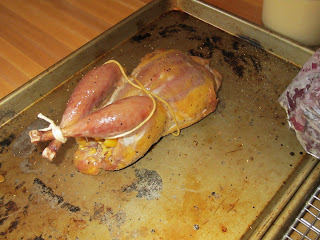The beautiful thing about mushrooms is that they are extremely flavorful and "meaty". They give that umami flavor burst and they can often take center stage in a dish replacing meat. I love meat very much but in this tasty vegetarian dish, the meat isnt missed in the least. Mushrooms are also extremely good for you as they absorb and eliminate toxins from the body. The mushrooms pictured below were bought from a farmers market from a lady who specializes in cultivating and wild foraging mushrooms. The varieties below are Beech, Pearl and Yellow Oyster, Crimini, and Wood Ear, but feel free to use any three or more kinds of mushrooms of your liking for this recipe.
Mushroom Ragout Recipe
2 T extra virgin olive oil
1 small onion fine dice
2 cloves garlic minced
1 small shallot minced
1 lb mushrooms cut into chunks (@ least 3 different varieties) washed and dried thoroughly
few sprigs thyme and rosemary
2 T tomato paste
1 cup chicken stock
1/4 cup white wine
2 T balsamic vinegar
2 T cold butter
1 T chopped parsley
Heat half the olive oil over medium high heat in a large saute pan and sear the mushrooms in the pan taking care not to crowd them. Toss in the thyme and rosemary sprigs. Saute the mushrooms until they release their juices and then reabsorb most of them. Remove to a plate and saute the onion, shallot, and garlic in the rest of the olive oil, then add the mushrooms back in the pan along with the herbs. Next deglaze with the wine and then add the tomato paste and chicken stock. Simmer for 15 min until mushrooms are tender and sauce thickens. Finish with the balsamic, mount in the cold butter, and add the parsley. Season with sea salt and fresh cracked pepper. Ladle over polenta.
1/2 lb beet greens
1 small onion julienned
1 T extra virgin olive oil
splash soy sauce, white wine, and chicken stock
Sea salt and pepper to taste
Sweat out the onions in the oil over medium heat, and add the beet greens, saute until wilted then add the liquids and lower the heat. Simmer until all the liquid has been absorbed. Transfer to a plate to cool. Once cooled squeeze out most of the liquid in the greens and transfer to a cutting board to chop finely. This will give the greens a different texture and make them more incorporated into the dish. To serve, spoon a wad on each side of the plate.
Creamy Polenta Recipe
1 qt chicken stock
1 cup polenta
a few dried mushrooms (I used porcini)
1/4 cup cream (preferably raw and organic)
2 T butter (preferably raw and organic)
2 tsp hot sauce
sea salt and pepper to taste
Simmer the chicken stock with the dried mushrooms for 10-15 min to flavor the broth for the polenta. Discard the dried mushrooms and bring the liquid up to a rolling boil. Pour in the polenta while whisking constantly. Turn the heat down to low and cook for 20 min stirring frequently and adding a touch of hot water if it gets too thick and starts sticking to the bottom. Next add the cream, butter, hot sauce, and season.
Lay a few scoops of polenta down on the plate and pour the Ragout over top. Serve the beet greens on the side and the finishing touch it Black Radish matchsticks tossed in a bit of lemon juice and walnut oil. Grate some parmesan cheese over top and serve. Carnivores and Herbivores alike will thank you.








































